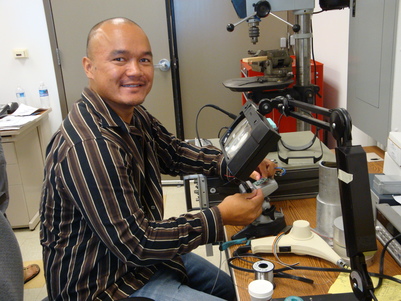Marco Bucao was raised on the island of Kaua‘i, where he graduated from Kaua‘i High School in 2002. He originally attended Kaua‘i Community College for two years, majoring in Liberal Arts, then one year at Honolulu Community College in the Computing Electronics Networking Technology (CENT) program. Marco’s college studies were put on hold as he enlisted in the U.S. Army for six years as an Engineer Mechanic, deploying twice to Iraq. Now, Marco is back at Kaua‘i Community College where he plans to complete his Associate of Science degree in Electronics Technology, then transfer off-island to obtain his Bachelor’s. Marco enjoys diving, surfing, fishing, and trucks.
Home Island: Kaua‘i
High School: Kaua‘i High School
Institute when accepted: Kaua‘i Community College
Project Title: Determining Conic Surface and Deviation Points of a Telescope Mirror Using Laser Tracking Technology
Project Site: Institute for Astronomy, Maui
Mentor: Jeffrey Kuhn
This is a metrology effort to support a two-meter off-axis primary mirror for the PLANETS telescope. The Institute for Astronomy’s interferomic laser tracker is used to determine the deviation points and conic surface of a mirror to be used in telescopes. This metrology tool is accurate to within a few microns of measurement. The laser tracker measures a cluster of points on the surface of a mirror. The deviation of the surface of the mirror from ideal can be precisely quantified. That data is piped into a program Jeff Kuhn is writing using Interactive Data Language (IDL) to characterize the deviation of the mirror surface and also create a graphical representation of the results. Eventually this data would feed into the polishing process. So far we have measured the same mirror three times but only used the best data to create the IDL program, which is still being worked on. Currently we are designing a linear xy-axis moving stage to move the corner reflector to provide a systematic way of measuring mirrors. Mirrors would then be sent off for polishing. It would take a considerable amount of time to polish the mirrors by using a water jet stream technology. In the end, this program would help accurately locate deviation points and help determine a telescope’s conic surface.
